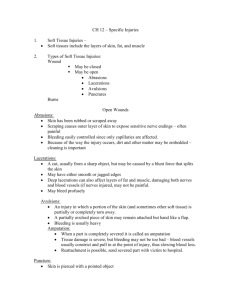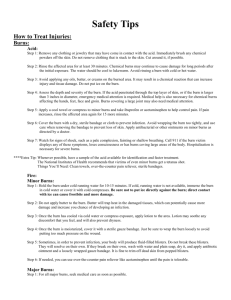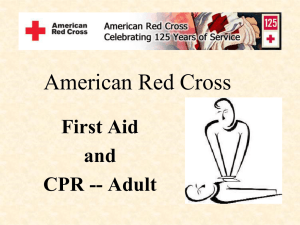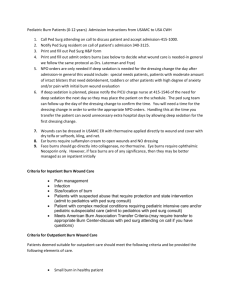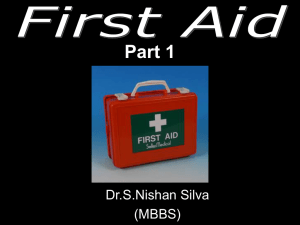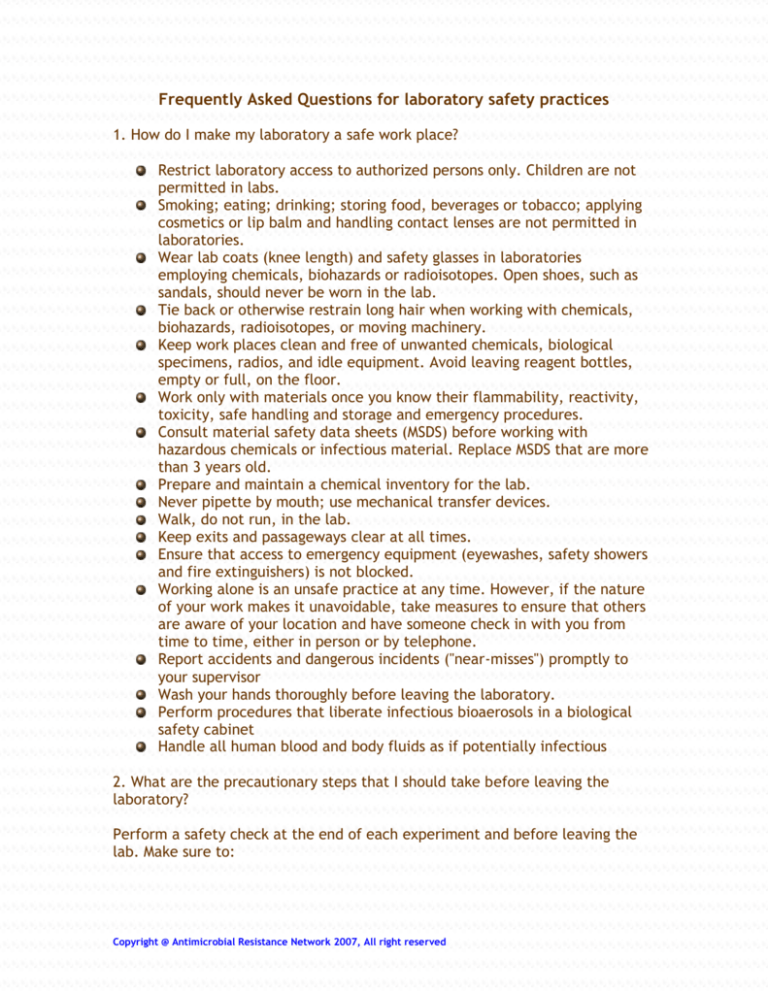
Frequently Asked Questions for laboratory safety practices
1. How do I make my laboratory a safe work place?
Restrict laboratory access to authorized persons only. Children are not
permitted in labs.
Smoking; eating; drinking; storing food, beverages or tobacco; applying
cosmetics or lip balm and handling contact lenses are not permitted in
laboratories.
Wear lab coats (knee length) and safety glasses in laboratories
employing chemicals, biohazards or radioisotopes. Open shoes, such as
sandals, should never be worn in the lab.
Tie back or otherwise restrain long hair when working with chemicals,
biohazards, radioisotopes, or moving machinery.
Keep work places clean and free of unwanted chemicals, biological
specimens, radios, and idle equipment. Avoid leaving reagent bottles,
empty or full, on the floor.
Work only with materials once you know their flammability, reactivity,
toxicity, safe handling and storage and emergency procedures.
Consult material safety data sheets (MSDS) before working with
hazardous chemicals or infectious material. Replace MSDS that are more
than 3 years old.
Prepare and maintain a chemical inventory for the lab.
Never pipette by mouth; use mechanical transfer devices.
Walk, do not run, in the lab.
Keep exits and passageways clear at all times.
Ensure that access to emergency equipment (eyewashes, safety showers
and fire extinguishers) is not blocked.
Working alone is an unsafe practice at any time. However, if the nature
of your work makes it unavoidable, take measures to ensure that others
are aware of your location and have someone check in with you from
time to time, either in person or by telephone.
Report accidents and dangerous incidents ("near-misses") promptly to
your supervisor
Wash your hands thoroughly before leaving the laboratory.
Perform procedures that liberate infectious bioaerosols in a biological
safety cabinet
Handle all human blood and body fluids as if potentially infectious
2. What are the precautionary steps that I should take before leaving the
laboratory?
Perform a safety check at the end of each experiment and before leaving the
lab. Make sure to:
Copyright @ Antimicrobial Resistance Network 2007, All right reserved
Turn off gas, water, electricity, vacuum and compression lines and
heating apparatus
Return unused materials, equipment and apparatus to their proper
storage locations
Label, package and dispose of all waste material properly
Remove defective or damaged equipment immediately, and arrange to
have it repaired or replaced
Decontaminate any equipment or work areas that may have been in
contact with hazardous materials.
Leave behind protective clothing (lab coats, gloves, etc.) when leaving
the laboratory
Close and lock the door to the laboratory if you are the last one to leave
3. How do I handle burns to skin in the laboratory?
First aid treatment of skin burns encompasses the following:
If the burn is electrical in origin, ascertain that the victim is not in
contact with the power supply before touching him/her. If the victim
remains in contact with a power source, unplug the device or shut off
the main power switch at the electrical distribution panel.
Seek immediate medical treatment for all electrical burns, even if they
don't appear to be serious.
Remove jewelry, including watches, from the burned area.
Expose the burnt area, but avoid removing clothes that are stuck to the
skin.
If possible, immerse burnt surfaces in cold water for at least 10 minutes,
or apply cold wet packs.
Avoid applying lotions, ointments or disinfectants to a burn. First and
second degree burns can be washed with soap and water after the cool
down period.
Cover first and second degree burns with a moist bandage; apply dry
compresses to third degree burns and to entry and exit wounds of
electrical burns.
Do not burst blisters, as they form a natural barrier against infection.
4. What if during laboratory work I get a burn in the eye?
Burns to the eyes may be caused by chemical substances, heat (hot liquids,
steam, open flames, molten metal, etc.), or radiation from welding
procedures, laboratory lamps and lasers. Burns caused by ultraviolet, visible or
near-infrared radiation may not produce symptoms until 6-8 hours after
exposure. First aid procedures for chemical burns to the eyes are as follows:
Copyright @ Antimicrobial Resistance Network 2007, All right reserved
Go to the nearest eyewash and rinse for at least 20 minutes.
If you are wearing contact lenses, remove them as quickly as possible,
while continuing to flush.
Hold your eyelids open with your fingers.
Roll your eyeballs, so that water can flow over the entire surface of the
eye.
Lift your eyelids frequently to ensure complete flushing.
Cover the injured eye with dry sterile gauze pads while waiting for
medical attention.
Prevent the victim from rubbing or touching the eyes.
For heat burns, flush the eyes with cool water until the pain subsides.
Cover the eyes with dry sterile gauze pads; apply a wet compress to the
eyes if it is too painful to close them.
Send the victim for medical care. If the burn is the result of exposure to
a laser beam, advise emergency medical personnel of the characteristics
of the laser and the distance between the victim and the laser.
5. What should I do if I get a cut during work in the laboratory
First aid treatment for minor scrapes, scratches, cuts, lacerations or puncture
wounds include the following:
wash the wound and surrounding area with mild soap and running water
remove any dirt around the wound
cover with an adhesive dressing or gauze square taped on all sides with
adhesive tape
wounds caused by dirty, soiled or grimy objects should be examined by a
physician, who will determine whether a tetanus immunization is needed
if the wound was caused by an object that has contacted human blood or
body fluids, the victim must be seen by a physician immediately, as
immunization or post-exposure prophylaxis may be required.
If a wound is bleeding profusely, the first aider should attempt to stop
the bleeding as quickly as possible:
Elevate the injured area above the level of the heart, if possible, in
order to reduce the blood pressure to the area of the wound.
Apply direct pressure to the wound unless an object is protruding
from it (in this situation, apply pressure around the injury). Direct
pressure can be applied with the fingers of the hand, the palm of the
hand or with a pressure dressing.
If bleeding cannot be controlled with direct pressure, apply pressure
to the arteries supplying the injured area. This involves compressing
the artery between the wound and the heart, against a bone.
Do not remove a dressing that has become soaked with blood, as this
may interrupt the clotting process; apply an additional dressing on
top of the first.
Copyright @ Antimicrobial Resistance Network 2007, All right reserved
Avoid over-tightening of the dressing; i.e., do not cut off the blood
circulation to limbs.
As a tourniquet completely stops the flow of blood to beyond the
point of application, it should be applied only as a last resort, as in
the case of a severed limb.
What is necessary for the laboratory to handle emergency situations?
6. How do I make my First aid Kit?
Factors to consider in selecting a kit:
the supplies should be consistent with the types of injuries anticipated
in this research space (e.g., will there be burns, cuts, fractures,
contusions, or allergic reactions?)
its size must be appropriate to the number of people who will be using
the kit
supplies should be provided in single-use or -dose unit-type packs with
suitable wrapping to ensure sterility and hygiene
the case should be dust- and moisture-resistant with no sharp edges
Consider the most convenient storage method for easy access-wallmounted or portable?
the assortment choice shall have received final clearance from a
qualified medical expert.
As a practical model, the American National Standards Institute's Minimum
Requirements for Workplace First Aid Kits (ANSI Z308.1-1998) recommends that
basic units should contain:
1 absorbent compress (32 sq. in. with no side smaller than 4 in.)
16 adhesive bandages (1 × 3 in.)
Adhesive tape (total of 5 yd.)
10 individual-use antiseptic applications (0.5 g each)
6 individual-use burn treatment applications (0.5 g each)
2 pairs of medical exam gloves
4 sterile pads (3 × 3 in.)
1 triangular bandage (40 × 40 × 56 in
The emergency first aid procedures described below should be followed by a
consultation with a physician for medical treatment.
7. How to handle a needle stick injury?
First aid treatment for needle stick injuries includes the following:
Copyright @ Antimicrobial Resistance Network 2007, All right reserved
wash the wound and surrounding area with mild soap and running water
Remove any dirt around the injury site.
cover with an adhesive dressing or gauze square taped on all sides with
adhesive tape
if the needle stick injury is caused during the handling of human blood or
body fluids, the victim must be seen by a physician immediately, as
immunization or post-exposure prophylaxis may be required
Chemical safety:
8. How to handle chemical splash to the skin?
If the splash affects a large area of skin, go to the nearest shower and
rinse thoroughly for at least 20 minutes; remove contaminated clothing
while in the shower
For splashes involving a small skin area, proceed to the nearest clean
hand washing sink, remove contaminated clothing and jewelry and rinse
for 15 minutes.
9. How to handle chemical splash to the eyes?
Go to the nearest eyewash and rinse for at least 20 minutes.
If you are wearing contact lenses, remove them as quickly as possible,
while continuing to flush.
Hold your eyelids open with your fingers.
Roll your eyeballs, so that water can flow over the entire surface of the
eye.
Lift your eyelids frequently to ensure complete flushing.
Cover the injured eye with dry sterile gauze pads while waiting for
medical attention.
10. How to handle accidental chemical ingestion during work?
Toxic substances can enter and poison the body by inhalation, absorption
through the skin, ingestion or injection. When assisting a victim of poisoning:
Rush to the emergency ward for serious chemical ingestion
Provide first aid as required
Do not induce vomiting unless advised to do so by a reliable authority
Provide emergency medical personnel with the MSDS for the ingested
chemical. If the victim was overcome by the effect of the chemical and
has vomited, provide the ambulance technicians with a sample of the
vomitus.
Copyright @ Antimicrobial Resistance Network 2007, All right reserved
Always ensure that the victim receives medical attention, even if the
exposure is minor.
11. What is MSDS?
A material safety data sheet (MSDS) is a form containing data regarding
the properties of a particular substance.
An important component of product stewardship and workplace safety,
it is intended to provide workers and emergency personnel with
procedures for handling or working with that substance in a safe
manner, and includes information such as physical data (melting point,
boiling point, flash point, etc.), toxicity, health effects, first aid,
reactivity, storage, disposal, protective equipment, and spill handling
procedures.
The exact format of an MSDS can vary from source to source.
MSDS are a widely used system for cataloging information on chemicals,
chemical compounds, and chemical mixtures. MSDS information may
include instructions for the safe use and potential hazards associated
with a particular material or product.
MSDS can be found anywhere chemicals are being used.
There is also a duty to properly label substances on the basis of physicochemical, health and/or environmental risk.
Labels include hazard symbols such as the Saint Andrew's Cross (a black
diagonal cross on an orange background which is used in the European
Union to denote a harmful or irritant substance).
Fire Safety:
12. How to handle Laboratory fire?
The immediate response depends on the size of the fire. Laboratory personnel
should attempt to extinguish a fire only if it is clearly safe to do so with the
"Fire Extinguishers".
13. How to handle suspected fires?
All members of the laboratory should familiarize themselves with the locations
of the fire alarms and evacuation routes in the areas that they occupy. Anyone
discovering smoke, strong smell of burning or smell of an unusual nature,
should immediately:
Fire department of the hospital.
Alert the Building Emergency section, Building Serviceperson or Building
Director.
Copyright @ Antimicrobial Resistance Network 2007, All right reserved
14. How to handle known fire situations?
Shout "FIRE!" repeatedly to give the alert.
Pull the fire alarm.
Telephone the Hospital Fire Department.
Evacuate the premises in a swift, orderly fashion using the stairways
and/or fire escapes, but NOT the elevators, and following the
instructions of Evacuation Monitors.
Once outside the building, move away from the doors to enable others
to exit.
15. How to handle clothing fires?
If your clothing should catch fire, it is important not to run, as this would
provided additional air to support the flames. Remember the "Stop, Drop and
Roll" rule:
Stop where you are
Drop to the floor, and
Roll to smother the flames
As soon as the flames are extinguished, go to the nearest emergency shower to
cool burned areas with copious amounts of water. If someone else is on fire:
Immediately immobilize the victim and force him/her to roll on the
ground to extinguish the flames.
Assist in smothering the flames, using whatever is immediately available,
such as a fireproof blanket or clothing.
Give appropriate first aid.
Copyright @ Antimicrobial Resistance Network 2008, All right reserved
Copyright @ Antimicrobial Resistance Network 2007, All right reserved




